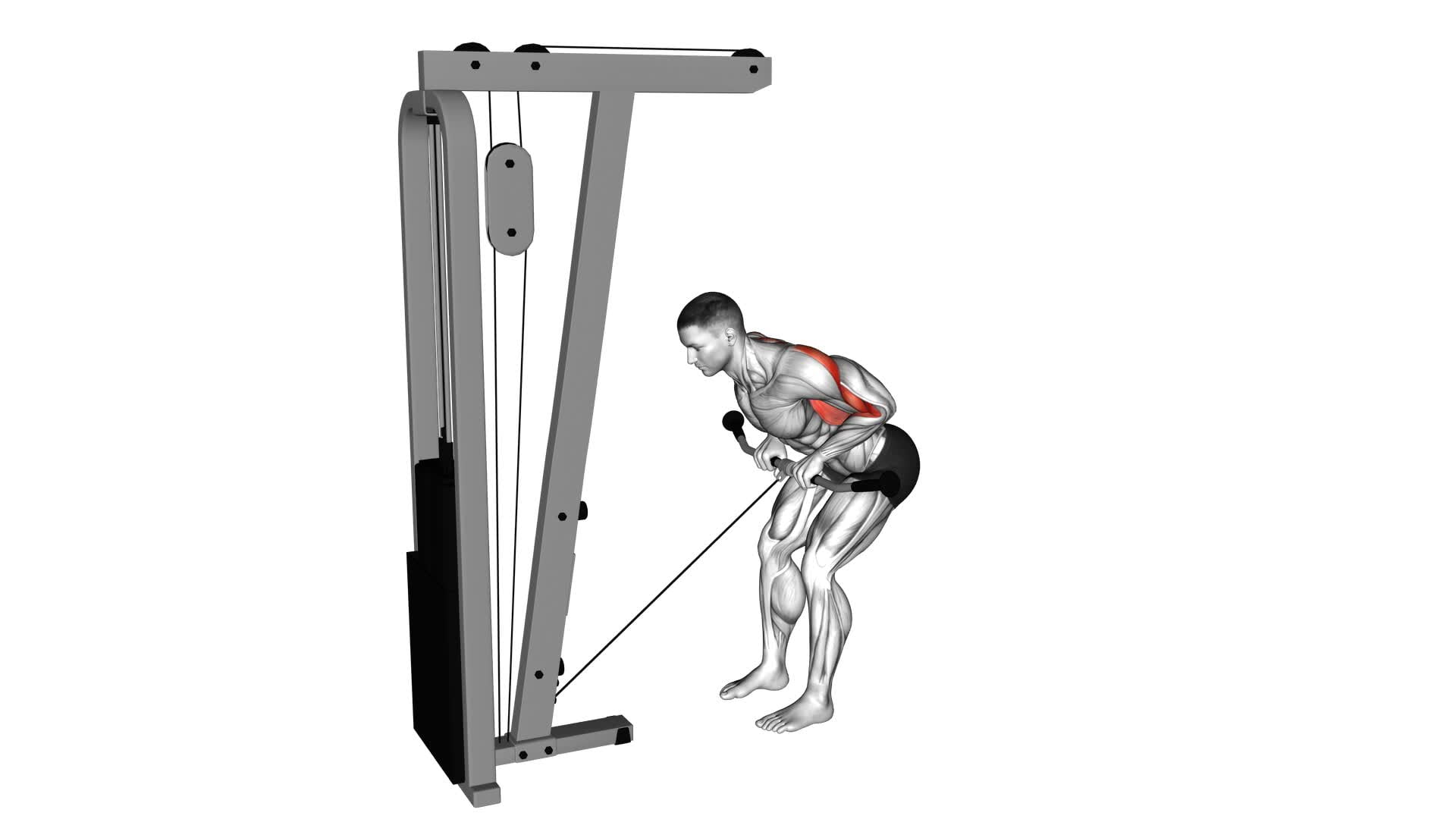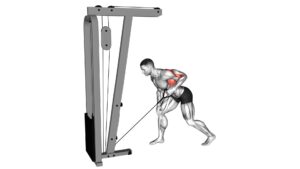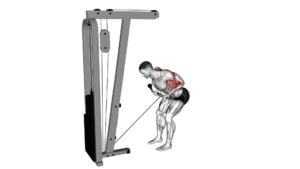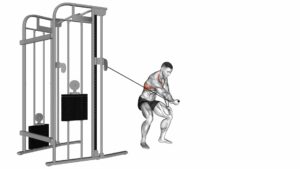Cable Bent Over Row – Video Exercise Guide & Tips

Looking to tone your back muscles? Get ready to try the cable bent over row! This exercise, demonstrated in our video guide, is an effective way to strengthen your back and improve posture.
Watch This Exercise Video
With a cable machine and proper form, you'll engage your lats, rhomboids, and traps for a challenging workout.
In this article, we'll provide you with tips and variations to ensure you get the most out of this exercise.
Let's get started!
Key Takeaways
- Cable Bent Over Row increases back strength
- Cable Bent Over Row improves posture
- Cable Bent Over Row targets upper back muscles
- Cable Bent Over Row enhances athletic performance
Benefits of Cable Bent Over Row
You can experience several benefits from incorporating the cable bent over row into your workout routine. This exercise is highly effective for increasing back strength and improving posture. By targeting the muscles in your upper back, including the rhomboids, trapezius, and latissimus dorsi, the cable bent over row helps to develop a strong and stable back. This increased back strength can enhance your overall athletic performance and reduce the risk of injury during other exercises or daily activities.
Furthermore, the cable bent over row is a great exercise for improving posture. Many people spend long hours sitting at a desk or hunched over electronic devices, leading to rounded shoulders and a forward head posture. The cable bent over row helps to counteract these negative effects by strengthening the muscles responsible for maintaining an upright posture. As you perform this exercise, focus on retracting your shoulder blades and squeezing your back muscles. Over time, this will help you develop better posture and alleviate any discomfort associated with poor alignment.
Incorporating the cable bent over row into your workout routine can have a significant impact on your back strength and posture. By consistently performing this exercise, you can build a strong and stable back, improve your overall athletic performance, and maintain a healthy posture.
Equipment and Setup
To properly set up for the cable bent over row, you need to ensure the cable height is appropriate for your height. Adjust the cable to a height where you can comfortably grip the handles with your arms fully extended.
It's also important to choose the appropriate equipment, such as a straight or V-bar handle, to target different muscles and vary your workout.
Proper Cable Height
Adjust the cable height on the equipment to ensure proper setup for the Cable Bent Over Row exercise. This is important because having the correct cable height will allow you to perform the exercise with proper form and maximize its benefits.
The Cable Bent Over Row is a great exercise for targeting your upper back muscles, but if the cable height is too high or too low, it can put unnecessary strain on your shoulders or limit your range of motion. To set the cable height, start by standing in front of the cable machine and adjusting the pulley to a height that's comfortable for you. The cable should be at chest level or slightly below. This will allow you to maintain proper body alignment and perform the exercise effectively.
Once you have adjusted the cable height, you can proceed to choose the appropriate equipment for the exercise.
Choosing Appropriate Equipment
Once you have determined the proper cable height, it's important to select the appropriate equipment for the Cable Bent Over Row exercise. Choosing the right cable machine and ensuring proper cable tension are crucial for an effective workout. Here are some tips to help you make the right choice:
- Look for a cable machine with adjustable weight stacks or plates, so you can easily increase or decrease the resistance.
- Make sure the machine has a sturdy and stable base to support your weight and movements.
- Check that the cables are in good condition and properly maintained to ensure smooth and consistent resistance.
- Consider the grip attachments available, such as straight bars, V-bars, or D-handles, to find the one that feels most comfortable and allows for proper form.
Proper Form and Technique
During the cable bent over row exercise, focus on maintaining a neutral spine position throughout the movement. This is crucial for proper form and technique, as it helps prevent injury and ensures maximum results.
One common mistake is rounding the back, which puts excessive stress on the spine and reduces the effectiveness of the exercise. To avoid this, keep your back straight and engage your core muscles to support your spine.
Another mistake is using momentum to pull the weight, rather than relying on your back muscles. This not only decreases the effectiveness of the exercise but also increases the risk of injury. Instead, focus on pulling the weight with controlled movements and a slow, controlled tempo.
To maximize results, ensure that you're fully extending your arms and squeezing your shoulder blades together at the top of the movement. This helps to target the muscles in your upper back and promotes muscle growth and strength.
Variations and Progressions
When it comes to variations and progressions of the cable bent over row, there are a few key points to keep in mind.
First, you can experiment with different grip options, such as an overhand or underhand grip, to target different muscles in your back.
Second, as you become stronger, gradually increase the weight you're lifting to continue challenging your muscles and promoting growth.
Different Grip Options
To vary your cable bent over row exercise, try different grip options such as wide, narrow, or neutral grip. Changing your grip can target different muscles and add variety to your workout routine. Here are some grip options you can try:
- Wide Grip: This grip involves placing your hands wider than shoulder-width apart on the cable attachment. It targets your upper back and helps develop width and thickness.
- Narrow Grip: With this grip, your hands are placed closer together, around shoulder-width apart. It emphasizes your middle back muscles and helps improve overall back strength.
- Neutral Grip: This grip involves using parallel handles or attaching a V-bar to the cable. It targets your middle back and biceps while reducing stress on your wrists and elbows.
- Overhand Grip: Also known as pronated grip, it involves gripping the bar with your palms facing down. It primarily targets your upper back muscles.
- Underhand Grip: Also known as supinated grip, it involves gripping the bar with your palms facing up. This grip primarily targets your biceps and lower back muscles.
Increasing Weight Over Time
To increase the weight over time for the cable bent over row exercise, focus on progressively adding resistance. This will help you continually challenge your muscles and increase the intensity of your workouts.
Start by selecting a weight that allows you to perform the exercise with proper form and control. As you become comfortable with the weight, gradually increase it by small increments. Aim to add weight every 1-2 weeks, depending on your strength and progress.
Keep track of the weights you use in a workout journal or a fitness app to monitor your progress over time. This will help you stay motivated and ensure that you're consistently pushing yourself to lift heavier weights and achieve your fitness goals.
Adding Unilateral Movements
To enhance the effectiveness of your cable bent over row exercise, incorporate unilateral movements to engage each side of your body individually. Unilateral training involves performing exercises that target one side of your body at a time, which can help improve muscle activation and balance. Here are some variations and progressions you can try:
- Single-arm cable bent over row: Instead of using both arms to row the cable, use only one arm at a time. This will challenge your core stability and help you identify any strength imbalances between your left and right sides.
- Alternating cable bent over row: Row the cable with one arm, then switch to the other arm for the next repetition. This variation adds an element of coordination and can help improve overall upper body strength.
- Single-arm cable row with rotation: As you row the cable, rotate your torso towards the working arm. This movement engages your obliques and adds an extra challenge to your core stability.
- Single-arm cable row with pause: At the top of the row, hold the position for a few seconds before lowering the weight. This helps increase time under tension and promotes muscle growth.
Incorporating unilateral movements into your cable bent over row routine can help you achieve better muscle activation, improve balance, and overcome strength imbalances between your left and right sides. Remember to start with lighter weights and focus on maintaining proper form throughout each repetition.
Common Mistakes to Avoid
Avoid bending your back excessively during the Cable Bent Over Row exercise. This is a common mistake that many people make, but it can lead to injury if not corrected. By maintaining proper posture, you can avoid straining your back and ensure that you're targeting the correct muscles during the exercise.
To maintain proper posture, start by standing with your feet shoulder-width apart and your knees slightly bent. Keep your core engaged and your back straight throughout the exercise. Avoid rounding your shoulders or hunching forward, as this can put unnecessary strain on your back.
Another mistake to avoid is using too much weight. While it may be tempting to go heavy, using excessive weight can compromise your form and increase the risk of injury. Start with a weight that allows you to perform the exercise with proper form and gradually increase the weight as you become stronger.
Lastly, avoid jerking or using momentum to complete the movement. The Cable Bent Over Row is a controlled exercise that targets the muscles in your back. By using momentum, you take the focus away from the target muscles and increase the risk of injury. Instead, focus on performing the exercise with slow and controlled movements, squeezing your shoulder blades together at the top of the movement.
Tips for Maximizing Results
To maximize your results with the Cable Bent Over Row, focus on maintaining proper form and engaging the targeted muscles throughout the exercise. Here are some tips to help you maximize gains and increase workout intensity:
- Use a challenging weight: Choose a weight that allows you to complete the desired number of reps with proper form, but still challenges you. This will help stimulate muscle growth and increase strength.
- Squeeze your shoulder blades: As you pull the cable towards your body, focus on squeezing your shoulder blades together. This will help activate the muscles in your upper back, leading to better results.
- Control the movement: Avoid using momentum to perform the exercise. Instead, focus on controlling the weight throughout the entire range of motion. This will increase the time under tension and enhance muscle activation.
- Incorporate pauses: At the top of the movement, pause for a second and squeeze your back muscles. This will further engage the targeted muscles and enhance the effectiveness of the exercise.
Frequently Asked Questions
How Many Sets and Reps Should I Do for the Cable Bent Over Row Exercise?
For the cable bent over row exercise, the recommended sets and reps will depend on your fitness level and goals. Generally, it's recommended to start with 3-4 sets of 8-12 reps. This will help you build strength and muscle endurance.
However, you can also vary the sets and reps to challenge your muscles in different ways. For example, you can try doing heavier weights with lower reps for strength gains, or lighter weights with higher reps for muscle endurance.
Can I Substitute the Cable Machine With Dumbbells or a Barbell for the Bent Over Row?
Yes, you can substitute the cable machine with dumbbells or a barbell for the bent over row exercise. Using dumbbells allows for greater range of motion and can help improve stability. Barbell rows engage more muscles and can increase overall strength.
To perform the exercise with dumbbells, stand with your feet shoulder-width apart, bend forward at the hips while keeping your back straight, and pull the dumbbells towards your chest.
With a barbell, grip the bar with an overhand grip, bend forward, and row the bar towards your abdomen.
Is the Cable Bent Over Row Suitable for Beginners or Should It Be Reserved for More Advanced Lifters?
The cable bent over row can be suitable for beginners, as it allows for modifications to make the exercise more manageable. Using the cable machine provides a controlled and stable resistance, making it easier to maintain proper form and reduce the risk of injury.
Additionally, the cable resistance allows for a greater range of motion and targets the back muscles more effectively compared to dumbbells or a barbell. This can help beginners develop strength and improve their posture.
Can I Perform the Cable Bent Over Row Exercise if I Have a History of Lower Back Pain?
If you have a history of lower back pain, you may want to reconsider performing the cable bent over row exercise. This exercise can put stress on your lower back and potentially worsen your pain. It's important to prioritize your safety and well-being.
Instead, consider alternative exercises that are more gentle on your lower back, such as the seated cable row or the dumbbell bent over row.
Always consult with a healthcare professional before starting any new exercise routine.
How Does the Cable Bent Over Row Compare to Other Rowing Exercises in Terms of Muscle Activation and Effectiveness?
The cable bent over row is a great exercise for building back muscles. However, how does it compare to the barbell row?
In terms of muscle activation and effectiveness, both exercises target the back muscles. But the cable bent over row allows for more variation and modification.
With different cable attachments and grip positions, you can target specific muscles like the lats or rhomboids. This versatility makes the cable bent over row a valuable exercise for building back muscles.
Conclusion
In conclusion, the cable bent over row is a highly effective exercise for targeting the muscles in your back and arms.
By using proper form and technique, you can maximize your results and avoid common mistakes.
Additionally, there are variations and progressions that can be implemented to challenge yourself and continue making progress.
Incorporating this exercise into your fitness routine will help you build strength and improve your overall physique.

Author
Years ago, the spark of my life’s passion ignited in my mind the moment I stepped into the local gym for the first time. The inaugural bead of perspiration, the initial endeavor, the very first surge of endorphins, and a sense of pride that washed over me post-workout marked the beginning of my deep-seated interest in strength sports, fitness, and sports nutrition. This very curiosity blossomed rapidly into a profound fascination, propelling me to earn a Master’s degree in Physical Education from the Academy of Physical Education in Krakow, followed by a Sports Manager diploma from the Jagiellonian University. My journey of growth led me to gain more specialized qualifications, such as being a certified personal trainer with a focus on sports dietetics, a lifeguard, and an instructor for wellness and corrective gymnastics. Theoretical knowledge paired seamlessly with practical experience, reinforcing my belief that the transformation of individuals under my guidance was also a reflection of my personal growth. This belief holds true even today. Each day, I strive to push the boundaries and explore new realms. These realms gently elevate me to greater heights. The unique combination of passion for my field and the continuous quest for growth fuels my drive to break new ground.



